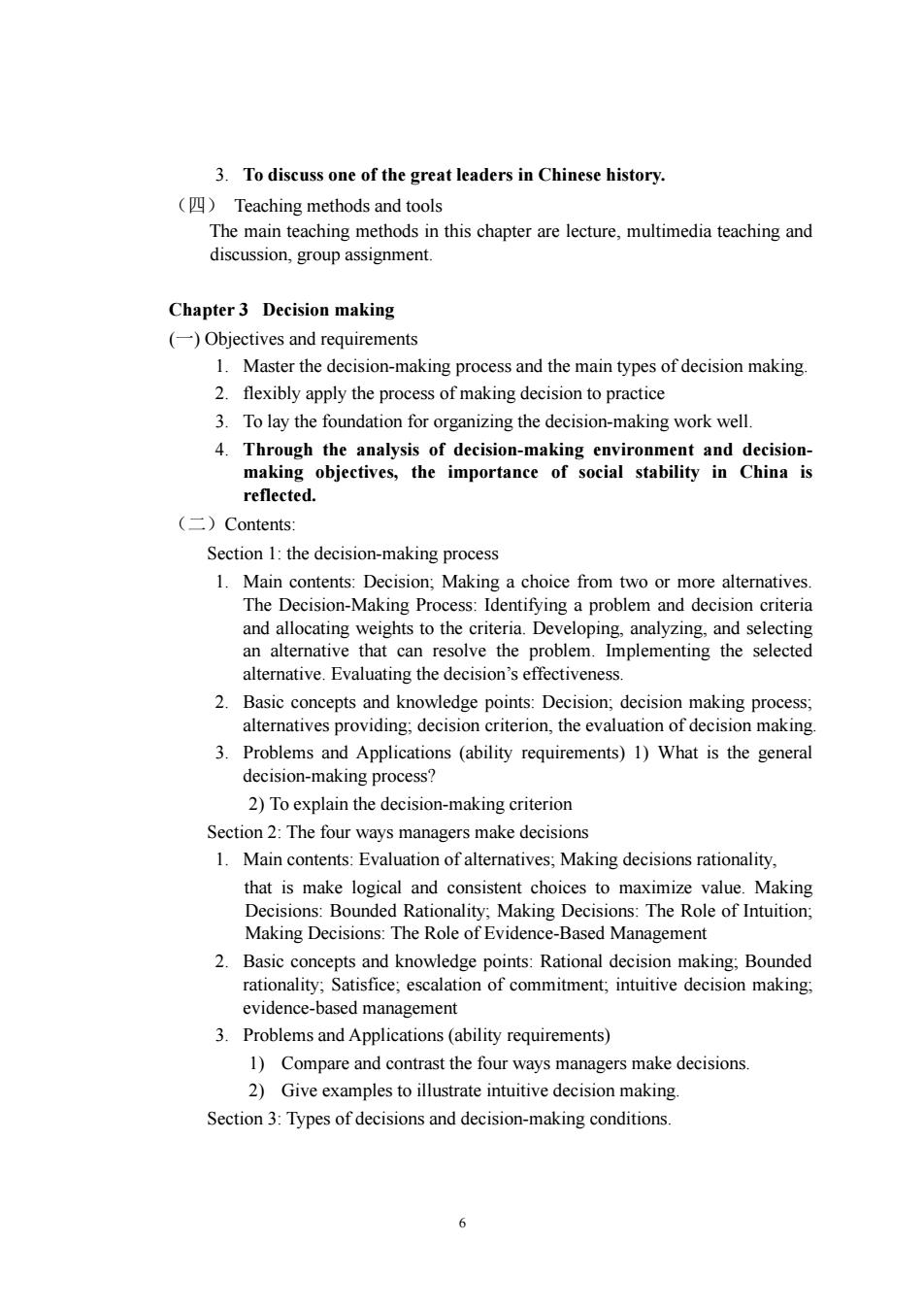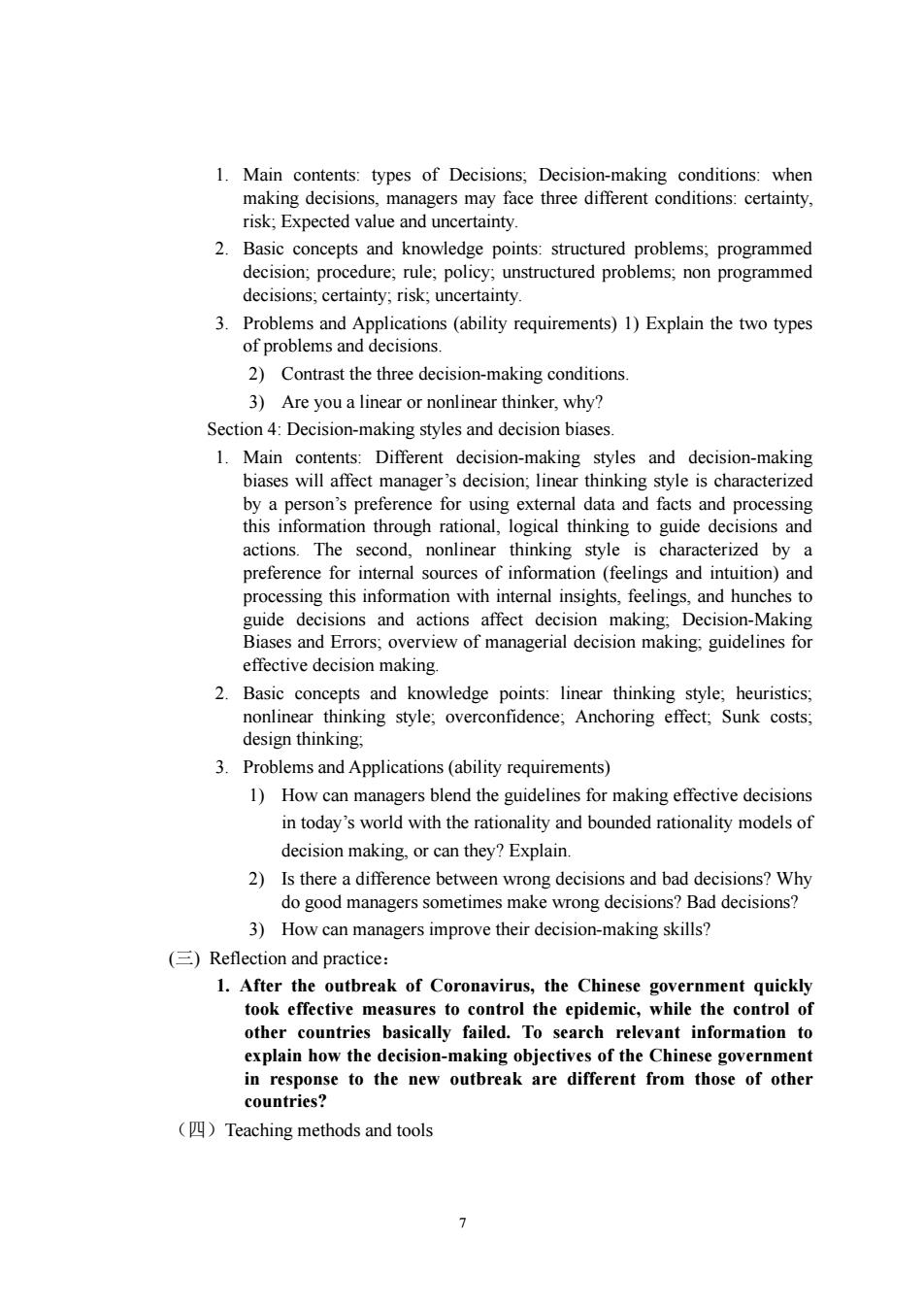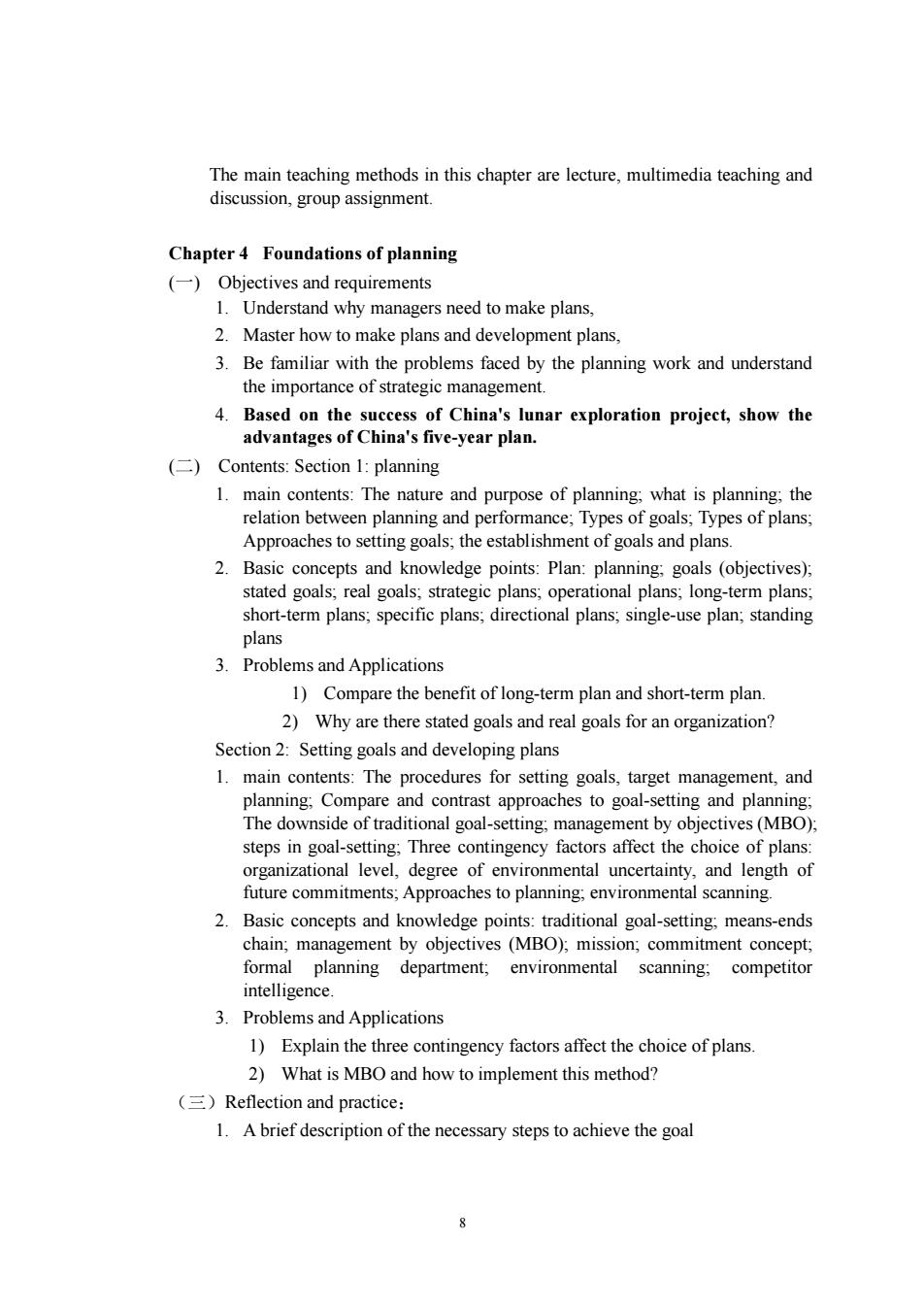
3.To discuss one of the great leaders in Chinese history. ()Teaching methods and tools The main teaching methods in this chapter are lecture,multimedia teaching and discussion,group assignment. Chapter 3 Decision making (-)Objectives and requirements 1.Master the decision-making process and the main types of decision making. 2.flexibly apply the process of making decision to practice 3.To lay the foundation for organizing the decision-making work well. 4.Throu making enviro ment and decision objective the importance of socia tability in n China s reflected (二)Contents: Section 1:the decision-making process 1.Mincontents Decision:Making a choice fom two or more altematives Mal ng Proc 1d ing a pro and d alloca g v sto the ia.De and sel tin h ca blem.Implementing the selecte alterative.Evaluating the decision's effectiveness. 2.Basic concepts and knowledge points:Decision;decision making process alternatives providing.decision criterion,the evaluation of decision making 3.Problems and Applications(ability requirements)1)What is the general decision-making process? 2)To explain the decision-making criterion Section 2:The four ways managers make decisions 1.Main contents:Evaluation of alternatives:Making decisions rationality that is make logical and consistent choices to maximize value.Making Decisions:Bounded Rationality;Making Decisions:The Role of Intuition; Making Decisions:The Role of Evidence-Based Management 2.Basic oncepts and knowledge points:Rational decision making:Bounded rationality:Sa tisfice:escalation of commitment;intuitived lecision making. evidence-based management 3.Problems and Applications(ability requirements) 1)Compare and contrast the four ways managers make decisions. 2)Give examples to illustrate intuitive decision making Section 3:Types of decisions and decision-making conditions. 6
6 3. To discuss one of the great leaders in Chinese history. (四) Teaching methods and tools The main teaching methods in this chapter are lecture, multimedia teaching and discussion, group assignment. Chapter 3 Decision making (一) Objectives and requirements 1. Master the decision-making process and the main types of decision making. 2. flexibly apply the process of making decision to practice 3. To lay the foundation for organizing the decision-making work well. 4. Through the analysis of decision-making environment and decision- making objectives, the importance of social stability in China is reflected. (二)Contents: Section 1: the decision-making process 1. Main contents: Decision; Making a choice from two or more alternatives. The Decision-Making Process: Identifying a problem and decision criteria and allocating weights to the criteria. Developing, analyzing, and selecting an alternative that can resolve the problem. Implementing the selected alternative. Evaluating the decision’s effectiveness. 2. Basic concepts and knowledge points: Decision; decision making process; alternatives providing; decision criterion, the evaluation of decision making. 3. Problems and Applications (ability requirements) 1) What is the general decision-making process? 2) To explain the decision-making criterion Section 2: The four ways managers make decisions 1. Main contents: Evaluation of alternatives; Making decisions rationality, that is make logical and consistent choices to maximize value. Making Decisions: Bounded Rationality; Making Decisions: The Role of Intuition; Making Decisions: The Role of Evidence-Based Management 2. Basic concepts and knowledge points: Rational decision making; Bounded rationality; Satisfice; escalation of commitment; intuitive decision making; evidence-based management 3. Problems and Applications (ability requirements) 1) Compare and contrast the four ways managers make decisions. 2) Give examples to illustrate intuitive decision making. Section 3: Types of decisions and decision-making conditions

1.Main contents:types of Decisions:Decision-making conditions:when making decisions,managers may face three different conditions:certainty, risk;Expected value and uncertainty. 2.Basic concepts and knowledge points structured p roble ms;programmed re;r rule policy unstructured problems;non programmed ,risk,uncertainty. 3.Problems and Applications (ability requirements)1)Explain the two types of problems and decisions. 2)Contrast the three decision-making conditions. 3)Are you a linear or nonlinear thinker,why? Section 4:Decision-making styles and decision biases. 1.Main contents:Different decision-making styles and decision-making biases will affect manager's decision;linear thinking style is characterized by ren ing atio cal thin and pr facts ec actions ecor nonlinea nking styl by preference for internal sources of information (feelings and i processing this information with internal insights,feelings,and hunches to guide decisions and actions affect decision making:Decision-Making Biases and Errors;overview of managerial decision making;guidelines for effective decision making. 2.Basic concepts and knowledge p ints:linea thinking style; euristics hinking style;overconfidence;Anchoring effect;Sunk costs: 3.Problems and Applications(ability requirements) 1)How can managers blend the guidelines for making effective decisions in today's world with the rationality and bounded rationality models of decision making.or can they?Explain 2)Is there a difference between wrong decisions and bad decisions?Why do good managers sometimes make wrong decisions?Bad decisions? 3)How can managers improve their decision-making skills? ()Reflection and practice: 1.After the outbreak of Coronavirus,the Chinese government quickly took effective measures to control the epidemic,while the control of other countries basically failed.To search relevant information to explain how the decision-making objectives of the Chinese government in response to the new outbreak are different from those of other countries? (Teaching methods and tools >
7 1. Main contents: types of Decisions; Decision-making conditions: when making decisions, managers may face three different conditions: certainty, risk; Expected value and uncertainty. 2. Basic concepts and knowledge points: structured problems; programmed decision; procedure; rule; policy; unstructured problems; non programmed decisions; certainty; risk; uncertainty. 3. Problems and Applications (ability requirements) 1) Explain the two types of problems and decisions. 2) Contrast the three decision-making conditions. 3) Are you a linear or nonlinear thinker, why? Section 4: Decision-making styles and decision biases. 1. Main contents: Different decision-making styles and decision-making biases will affect manager’s decision; linear thinking style is characterized by a person’s preference for using external data and facts and processing this information through rational, logical thinking to guide decisions and actions. The second, nonlinear thinking style is characterized by a preference for internal sources of information (feelings and intuition) and processing this information with internal insights, feelings, and hunches to guide decisions and actions affect decision making; Decision-Making Biases and Errors; overview of managerial decision making; guidelines for effective decision making. 2. Basic concepts and knowledge points: linear thinking style; heuristics; nonlinear thinking style; overconfidence; Anchoring effect; Sunk costs; design thinking; 3. Problems and Applications (ability requirements) 1) How can managers blend the guidelines for making effective decisions in today’s world with the rationality and bounded rationality models of decision making, or can they? Explain. 2) Is there a difference between wrong decisions and bad decisions? Why do good managers sometimes make wrong decisions? Bad decisions? 3) How can managers improve their decision-making skills? (三) Reflection and practice: 1. After the outbreak of Coronavirus, the Chinese government quickly took effective measures to control the epidemic, while the control of other countries basically failed. To search relevant information to explain how the decision-making objectives of the Chinese government in response to the new outbreak are different from those of other countries? (四)Teaching methods and tools

The main teaching methods in this chapter are lecture,multimedia teaching and discussion,group assignment. Chapter 4 Foundations of planning (Objectives and requirements 1.Understand why managers need to make plans, 2.Master how to make plans and development plans, 3.Be familiar with the problems faced by the planning work and understand the importance of strategic management. 4.Based on the success of China's lunar exploration project,show the advantages of China's five-year plan. ()Contents:Section 1:planning ents:The nature and purpose of planning ing:the nce;lypes o goals:Types of plans, Approaches to setting goals;the establishment of goals and plans 2.Basic concepts and knowledge points:Plan:planning:goals (objectives); stated goals;real goals;strategic plans,operational plans;long-term plans; short-term plans; specific plans,directional plans single-use plan standing plans 3.Problems and Applications 1)Compare the benefit of long-term plan and short-term plan 2)Why are there stated goals and real goals for an organization? Section 2:Setting goals and developing plans 1.main contents:The procedures for setting goals,target management,and planning:Compare and contrast approaches to goal-setting and planning: The downside of traditional goal-setting:management by objectives(MBO) steps in goal-setting:Three contingency factors affect the choice of plans. nizational level de e of e m ntal and len oth of aches to pl g.envi ntal se 2.Basic concepts and knowledge points:traditional goal-setting,means-ends chain;management by objectives(MBO),mission;commitment concept; formal planning department:environmental scanning:competitor intelligence. 3.Problems and Applications 1)Explain the three contingency factors affect the choice of plans. 2)What is MBO and how to implement this method? ()Reflection and practice: 1.A brief description of the necessary steps to achieve the goal
8 The main teaching methods in this chapter are lecture, multimedia teaching and discussion, group assignment. Chapter 4 Foundations of planning (一) Objectives and requirements 1. Understand why managers need to make plans, 2. Master how to make plans and development plans, 3. Be familiar with the problems faced by the planning work and understand the importance of strategic management. 4. Based on the success of China's lunar exploration project, show the advantages of China's five-year plan. (二) Contents: Section 1: planning 1. main contents: The nature and purpose of planning; what is planning; the relation between planning and performance; Types of goals; Types of plans; Approaches to setting goals; the establishment of goals and plans. 2. Basic concepts and knowledge points: Plan: planning; goals (objectives); stated goals; real goals; strategic plans; operational plans; long-term plans; short-term plans; specific plans; directional plans; single-use plan; standing plans 3. Problems and Applications 1) Compare the benefit of long-term plan and short-term plan. 2) Why are there stated goals and real goals for an organization? Section 2: Setting goals and developing plans 1. main contents: The procedures for setting goals, target management, and planning; Compare and contrast approaches to goal-setting and planning; The downside of traditional goal-setting; management by objectives (MBO); steps in goal-setting; Three contingency factors affect the choice of plans: organizational level, degree of environmental uncertainty, and length of future commitments; Approaches to planning; environmental scanning. 2. Basic concepts and knowledge points: traditional goal-setting; means-ends chain; management by objectives (MBO); mission; commitment concept; formal planning department; environmental scanning; competitor intelligence. 3. Problems and Applications 1) Explain the three contingency factors affect the choice of plans. 2) What is MBO and how to implement this method? (三)Reflection and practice: 1. A brief description of the necessary steps to achieve the goal